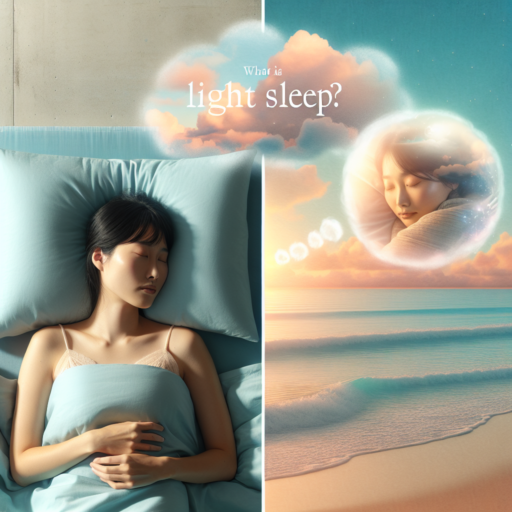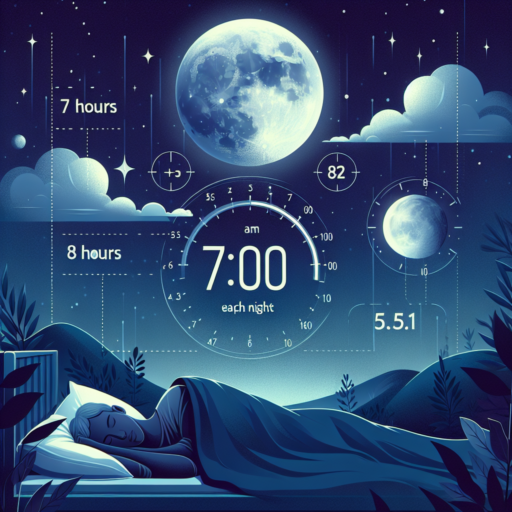Understanding What Light Sleep Is
When we discuss sleep, understanding its various phases is crucial for grasping how rest affects our overall health and well-being. Light sleep, often overseen in its importance, serves as a key transitional stage, cushioning the shift into deeper, more restorative sleep stages. It is during this phase that our body begins to slow down its physiological processes, preparing us for the journey into the realm of deep sleep.
The Characteristics of Light Sleep
Light sleep, marked by slower brain waves compared to the wakefulness of day-to-day activities, is characterized by its unique attributes. During this stage, which encompasses the first and second phases of the non-REM (Rapid Eye Movement) sleep, our heart rate and breathing slow down, and our muscles begin to relax, albeit with occasional twitches. It’s a period of easy awakening, which although might seem a drawback, actually helps in transitioning between waking and sleeping states seamlessly.
In the grand scheme of sleep cycles, light sleep acts as both the opener and closer, effectively bookending deeper sleep stages. This means that not only is it critical for easing us into the necessary deep sleep but it also plays a significant role in filling the spaces in our sleep cycles, ensuring we get a full night’s rest. Understanding this layer of our sleep architecture offers insights into how to optimize our sleep for better health and alertness.
The Importance of Light Sleep in Your Sleep Cycle
Understanding the importance of light sleep in your sleep cycle is crucial for optimizing overall health and well-being. Light sleep, often seen as the bridge between wakefulness and deeper stages of sleep, plays a significant role in cognitive processing and memory consolidation. As we navigate through the cycles of sleep, light sleep lays the foundation for the more restorative phases of deep sleep and REM (Rapid Eye Movement) sleep that follow.
During light sleep, the body begins to prepare itself for the deeper stages of sleep that are crucial for physical restoration. It’s a time when heart rate and breathing slow down, muscles relax, and the body’s energy is preserved and restored. This stage of sleep is also where the majority of our sleeping time is spent. Hence, ensuring a sufficient duration of light sleep can significantly impact one’s ability to feel rested and rejuvenated upon waking.
Moreover, researchers have found that light sleep is critical for the processing of emotions and experiences. This stage helps the brain sift through the day’s events, consolidating memories and learning, which are vital for emotional health and maintaining cognitive functions. By optimizing light sleep, individuals can enhance their ability to learn new skills, retain information, and regulate their emotions more effectively.
How Does Light Sleep Affect Your Health?
Understanding how light sleep impacts your health is essential for optimizing your well-being. Light sleep, also known as stage 1 and stage 2 of the non-rapid eye movement (NREM) phase, plays a crucial role in your overall sleep cycle. However, an imbalance or excessive amount of light sleep can have various effects on both your physical and mental health.
Physical Health Implications
From a physical perspective, inadequate deep sleep due to excessive light sleep can lead to decreased immune system function. This makes you more susceptible to infections and can slow down your recovery from illness. Moreover, your body misses out on the opportunity to repair itself, affecting muscle growth, tissue repair, and hormone regulation. It’s particularly problematic for those who engage in high-level physical activities or those recovering from physical ailments.
Mental Health and Cognitive Effects
Excess light sleep also affects your cognitive functions and mental health. It can lead to poor concentration, memory issues, and an increased risk of mood disorders like depression and anxiety. The restorative stages of sleep are crucial for memory consolidation and emotional regulation, and without sufficient deep sleep, your brain struggles to perform these vital processes. This can make daily tasks more challenging and affect your overall quality of life.
In conclusion, while light sleep is a normal part of the sleep cycle, its proportion and quality should be carefully monitored. Ensuring that you progress through the complete range of sleep stages each night is fundamental for maintaining both physical health and mental well-being. Addressing sleep issues promptly can prevent the long-term negative effects on your health.
No se han encontrado productos.
Identifying Light Sleep Stages on a Sleep Monitor
Understanding the various stages of sleep is crucial for enhancing sleep quality and overall health. Light sleep, often underestimated, plays a pivotal role in cognitive function and physical health. This section delves into identifying the light sleep stages on a sleep monitor, a tool increasingly becoming a part of many individuals’ sleep hygiene practices.
Sleep monitors, whether wearable devices or bedside machines, categorize sleep into multiple stages including light sleep, deep sleep, and REM sleep. **Light sleep** is characterized by slower brain waves than those of wakefulness, making it a transitional phase between being awake and moving into the deeper stages of sleep. In terms of identification on a sleep monitor, light sleep typically appears as a less intense pattern compared to deep sleep and REM, which show more pronounced brain activity.
Key Indicators of Light Sleep on a Monitor
- Reduced Movement: During light sleep, an individual’s physical movement decreases compared to the awake state. Sleep monitors detect and record these periods of reduced motion as indicators of light sleep.
- Slight Heart Rate Decrease: As the body enters light sleep, there’s a slight reduction in heart rate. Advanced sleep monitors track this change, distinguishing light sleep from more vigorous sleep stages.
- Brain Wave Patterns: Sleep monitors equipped with EEG technology can directly observe brain wave patterns. Light sleep stages show unique, slow-wave activity distinct from the awake state and deeper sleep phases.
Identifying these stages accurately can help users understand their sleep patterns better, making it possible to adjust their habits for improved sleep quality. It’s important for users to familiarize themselves with their monitor’s data interpretation to get the most accurate picture of their sleep architecture, including those all-important light sleep stages.
Ways to Improve the Quality of Your Light Sleep
Understanding the grave importance of enhancing the quality of your light sleep phase is fundamental for overall well-being. The light sleep stage acts as a bridge between wakefulness and deeper stages of sleep, playing a crucial role in mental and physical health. To aid in the improvement of this essential phase, several effective strategies can be explored.
Establish a Consistent Sleep Schedule
Maintaining a regular sleep pattern is paramount for optimizing the quality of your light sleep. Going to bed and waking up at the same time every day, even on weekends, can significantly enhance the efficiency of your sleep cycles, including the light sleep phase. This consistency helps to regulate your body’s internal clock, leading to a smoother transition between different stages of sleep.
Optimize Your Sleep Environment
An ideal sleep environment is crucial for not only entering the light sleep phase but also improving its quality. Ensuring your sleeping area is dark, quiet, and cool can dramatically affect how quickly and effectively you pass through light sleep. Utilizing items such as blackout curtains, white noise machines, and temperature controls can make a substantial difference in creating a conducive sleep atmosphere.
Limit Exposure to Screens Before Bed
In today’s digital age, it’s common to find ourselves scrolling through our phones or binge-watching our favorite TV shows up until bedtime. However, the blue light emitted by screens can significantly hinder the transition into the light sleep phase. Reducing screen time at least an hour before bed and engaging in relaxing activities such as reading or meditation can help prepare your body and mind for rest, enhancing the quality of your light sleep.
Differences Between Light Sleep, Deep Sleep, and REM Sleep
Understanding the differences between light sleep, deep sleep, and REM sleep is crucial for grasping how the sleep cycle works and its impact on our health and well-being. Each stage plays a unique role in the restorative processes of the body and mind.
Light Sleep: The Gateway to Deeper Rest
Light sleep serves as the entry point into the sleep cycle and is characterized by slow eye movements and a decrease in muscle activity. During this phase, individuals are easily awakened, but it’s essential for transitioning into deeper sleep stages. It’s in light sleep that the body starts to relax, heart rate and breathing slow down, and the brain begins to disengage from the stimuli of the waking world.
Deep Sleep: The Restoration Phase
In contrast, deep sleep is the most rejuvenating stage, allowing for bodily repair and growth. During deep sleep, brain waves slow to what are known as delta waves, and it becomes much harder to awaken someone. This phase is crucial for memory consolidation, cell regeneration, and boosting the immune system. Physical recovery, including muscle growth and energy replenishment, predominantly occurs during deep sleep, showcasing its vital role in overall health.
REM Sleep: The Dream Stage
REM sleep, or Rapid Eye Movement sleep, is distinct for its role in emotional regulation and memory. It’s during REM sleep that most dreaming occurs, with the brain becoming almost as active as it is while awake. This stage is essential for processing emotions, solidifying memories, and facilitating learning and creativity. Unlike deep sleep, the body is almost paralyzed during REM sleep, a phenomenon thought to prevent us from acting out our dreams.
Common Misconceptions About Light Sleep
Many of us have pondered what truly constitutes a good night’s sleep, yet misconceptions about light sleep often cloud our understanding. Contrary to popular belief, light sleep is not «wasted time». It plays a vital role in memory processing and recovery, acting as a bridge between deep sleep and REM sleep phases. Understanding and recognizing the facts behind light sleep can significantly enhance our approach towards achieving a restful night.
Another widespread misconception is that more deep sleep is always better than more light sleep. While deep sleep is crucial for physical recovery, light sleep occupies a larger portion of our sleep cycle for important reasons. It ensures the flexibility of transitioning between sleep phases, allowing our bodies and minds to adjust accordingly throughout the night. Therefore, a balance between all phases of sleep is key for optimal health and well-being.
Lastly, the assumption that one can train themselves to require less light sleep often leads to misguided efforts to alter sleep patterns. Our bodies have a natural rhythm and cycle through the various stages of sleep in a manner that supports overall health. Attempting to manipulate this natural process can disrupt sleep quality and have counterproductive effects on both mental and physical performance. Instead, focusing on healthy sleep habits and creating a conducive sleep environment are more effective strategies for enhancing sleep quality.How Your Lifestyle Influences Your Light Sleep Patterns
Understanding the intricate relationship between your everyday life choices and your light sleep patterns is crucial for enhancing overall sleep quality. The phases of sleep, especially light sleep, can be significantly impacted by the nuances of your daily routines. Light sleep serves as a transitional phase, playing a key role in memory processing and rejuvenation, making its optimization essential for a healthier lifestyle.
Physical Activity Levels are a significant aspect of your lifestyle influencing your light sleep patterns. Engaging in regular exercise can profoundly benefit your sleep architecture, increasing the duration of deep sleep and improving the efficiency of light sleep phases. However, the timing of exercise is critical; vigorous activities close to bedtime may lead to disruptions in your light sleep by increasing alertness and core body temperature. Finding a balance in your physical activities and their timing can promote more restorative sleep cycles.
Nutritional Choices play an equally pivotal role in shaping your sleep quality. Consuming a diet rich in magnesium, calcium, and vitamin B6 can enhance the quality of light sleep by supporting the body’s natural circadian rhythms and sleep-wake cycles. Conversely, caffeine and alcohol consumption, especially in the hours leading up to sleep, can severely impede the ability to transition smoothly through sleep stages, including light sleep. Moderation and strategic timing of intake are key to mitigating these negative impacts.
Your exposure to Light and Technology heavily influences your ability to fall and stay asleep. The blue light emitted by screens on smartphones, computers, and televisions can restrain the production of melatonin, the hormone responsible for regulating sleep-wake cycles. By creating a technology-free routine prior to bedtime and optimizing your exposure to natural light during the day, you can significantly improve not just the length but also the quality of your light sleep phases.
Tips for Tracking and Enhancing Your Light Sleep
Improving the quality of your light sleep is crucial for feeling refreshed and energized throughout the day. Fortunately, there are actionable strategies you can employ to better track and enhance this vital sleep phase. By integrating a few simple habits and tools into your routine, you can make significant improvements to your overall sleep quality.
Understanding the Role of Light Sleep
Before diving into tips for tracking and improving light sleep, it’s essential to understand its role in your sleep cycle. Light sleep acts as a transition phase between being fully awake and deeper sleep stages. It helps in memory consolidation and is key for cognitive functions and physical health. This phase occupies the largest portion of your sleep, making it a significant area for enhancement.
Tracking Your Sleep Patterns
One of the first steps towards improving your light sleep is effectively tracking it. This can be accomplished through the use of wearable technology like smartwatches and fitness bands. These devices can provide detailed insights into your sleep patterns, allowing you to identify areas for improvement. Look for features that offer breakdowns of your sleep stages, including the amount of time spent in light sleep, to better understand your sleep architecture.
Adopting Habits for Better Light Sleep
Improving your light sleep also involves adopting certain habits that promote better sleep quality. Establishing a consistent sleep schedule, creating a restful environment, and limiting exposure to blue light from screens before bedtime can significantly impact the quality of your light sleep. Additionally, engaging in relaxation techniques, such as meditation or deep breathing exercises before bed, can prepare your body for a night of restorative sleep. Incorporating physical activity into your daily routine, but not too close to bedtime, can also help in enhancing the quality of your light sleep.
FAQs About Light Sleep: Answering Your Common Questions
Many individuals have recurring questions about the nature of light sleep and its implications on overall health and well-being. Given the complexity of sleep stages and their impact on restorative rest, it’s no surprise that queries around light sleep are both common and critical to understand. Below, we dive into some frequently asked questions to shed light on this fundamental aspect of your sleep cycle.
What Characterizes Light Sleep?
Light sleep, or Stage 2 sleep, makes up a significant portion of your sleep cycle, acting as a transition phase between deep sleep and REM sleep. During this stage, your body starts to disengage from its surroundings, leading to a decrease in heart rate and body temperature. This period is pivotal for memory consolidation and cognitive function.
Why is Light Sleep Important?
Despite its seemingly passive nature, light sleep has a profound impact on your daily functioning. It serves as a preparation phase for deeper sleep stages, ensuring that your body undergoes the necessary repair and restoration processes. Moreover, the duration and quality of light sleep can influence mood, productivity, and even long-term health.
How Can I Improve My Light Sleep?
Improving the quality of your light sleep involves a combination of healthy sleep hygiene practices. This includes establishing a consistent sleep schedule, creating a restful environment free of distractions, and avoiding stimulants close to bedtime. Engaging in regular physical activity and mindfulness exercises can also enhance your light sleep stages.




